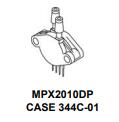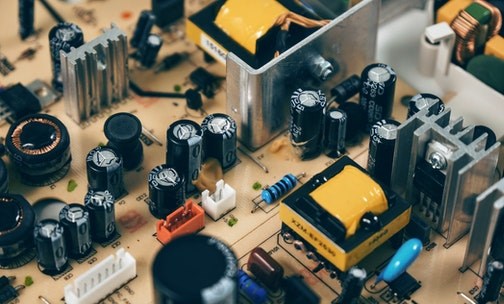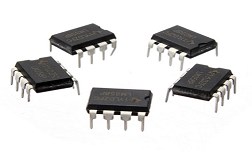MPX2010DP Pressure Sensor: MPX2010DP Datasheet and Block Diagram
MPX2010 Series Differential Pressure Sensor Wheatstone Bridge -40°C~125°C 1.45PSI (10kPa) Barbed ±1% 0 mV ~ 25 mV (10V) 10V~16V









MPX2010 Series Differential Pressure Sensor Wheatstone Bridge -40°C~125°C 1.45PSI (10kPa) Barbed ±1% 0 mV ~ 25 mV (10V) 10V~16V
MPX2010DP is a 0 kPa On-Chip Temperature Compensated and Calibrated Silicon Pressure Sensor. This article will cover its datasheet, feature, application, circuit and more details about MPX2010DP.

MPX2010 Differential Pressure Sensor for Arduino
MPX2010DP CAD Model
Symbol

mpx2010DP Symbol
Footprint

mpx2010 Footprint
3D Model

mpx2010DP 3D Model
MPX2010DP Outline

mpx2010DP Outline
MPX2010DP Description
The MPX2010DP belongs to the MPX2010 series silicon piezoresistive pressure sensors that provide a very accurate and linear voltage output directly proportional to the applied pressure.
These sensors house single monolithic silicon die with the strain gauge and thin-film resistor network integrated. The sensor is laser trimmed for precise span, offset calibration and temperature compensation.
MPX2010DP Feature
• Temperature Compensated over 0°C to +85°C
• Ratiometric to Supply Voltage
• Differential and Gauge Options
• Available in Easy-to-Use Tape & Reel
MPX2010DP Application
• Respiratory Diagnostics
• Air Movement Control
• Controllers
• Pressure Switching
MPX2010DP Block Diagram

mpx2010DP Block Diagram
The output voltage of the differential or gauge sensor increases with increasing pressure applied to the pressure side (P1) relative to the vacuum side (P2). Similarly, output voltage increases as an increasing vacuum are applied to the vacuum side (P2) relative to the pressure side (P1).
The figure above shows a block diagram of the internal circuitry on the stand-alone pressure sensor chip.
MPX2010DP Package

mpx2010DP Package
MPX2010DP Manufacturer
NXP Semiconductors enables secure connections and infrastructure for a smarter world, advancing solutions that make lives easier, better and safer. As the world leader in secure connectivity solutions for embedded applications, NXP is driving innovation in the secure connected vehicle, end-to-end security & privacy and smart connected solutions markets. Built on more than 60 years of combined experience and expertise, the company has 45,000 employees in more than 35 countries. Freescale Semiconductor has been acquired by NXP Semiconductor. Freescale Semiconductor parts are now a part of the NXP family (Dec 2015).
Specifications
- TypeParameter
- Factory Lead Time12 Weeks
- Package / Case
refers to the protective housing that encases an electronic component, providing mechanical support, electrical connections, and thermal management.
4-SIP Module - Surface Mount
having leads that are designed to be soldered on the side of a circuit board that the body of the component is mounted on.
NO - Mounting Feature
a process by which the operating system makes files and directories on a storage device (such as hard drive, CD-ROM, or network share) available for users to access via the computer's file system.
THROUGH HOLE MOUNT - Operating Temperature
The operating temperature is the range of ambient temperature within which a power supply, or any other electrical equipment, operate in. This ranges from a minimum operating temperature, to a peak or maximum operating temperature, outside which, the power supply may fail.
-40°C~125°C - Series
In electronic components, the "Series" refers to a group of products that share similar characteristics, designs, or functionalities, often produced by the same manufacturer. These components within a series typically have common specifications but may vary in terms of voltage, power, or packaging to meet different application needs. The series name helps identify and differentiate between various product lines within a manufacturer's catalog.
MPX2010 - Published2002
- Part Status
Parts can have many statuses as they progress through the configuration, analysis, review, and approval stages.
Active - Moisture Sensitivity Level (MSL)
Moisture Sensitivity Level (MSL) is a standardized rating that indicates the susceptibility of electronic components, particularly semiconductors, to moisture-induced damage during storage and the soldering process, defining the allowable exposure time to ambient conditions before they require special handling or baking to prevent failures
Not Applicable - ECCN Code
An ECCN (Export Control Classification Number) is an alphanumeric code used by the U.S. Bureau of Industry and Security to identify and categorize electronic components and other dual-use items that may require an export license based on their technical characteristics and potential for military use.
EAR99 - Applications
The parameter "Applications" in electronic components refers to the specific uses or functions for which a component is designed. It encompasses various fields such as consumer electronics, industrial automation, telecommunications, automotive, and medical devices. Understanding the applications helps in selecting the right components for a particular design based on performance, reliability, and compatibility requirements. This parameter also guides manufacturers in targeting their products to relevant markets and customer needs.
Board Mount - HTS Code
HTS (Harmonized Tariff Schedule) codes are product classification codes between 8-1 digits. The first six digits are an HS code, and the countries of import assign the subsequent digits to provide additional classification. U.S. HTS codes are 1 digits and are administered by the U.S. International Trade Commission.
8542.39.00.01 - Voltage - Supply
Voltage - Supply refers to the range of voltage levels that an electronic component or circuit is designed to operate with. It indicates the minimum and maximum supply voltage that can be applied for the device to function properly. Providing supply voltages outside this range can lead to malfunction, damage, or reduced performance. This parameter is critical for ensuring compatibility between different components in a circuit.
10V~16V - Output
In electronic components, the parameter "Output" typically refers to the signal or data that is produced by the component and sent to another part of the circuit or system. The output can be in the form of voltage, current, frequency, or any other measurable quantity depending on the specific component. The output of a component is often crucial in determining its functionality and how it interacts with other components in the circuit. Understanding the output characteristics of electronic components is essential for designing and troubleshooting electronic circuits effectively.
0 mV ~ 25 mV (10V) - Termination Style
"Termination style" in electronic components refers to the method used to connect the component to a circuit board or other electronic devices. It determines how the component's leads or terminals are designed for soldering or mounting onto the circuit board. Common termination styles include through-hole, surface mount, and wire lead terminations.Through-hole components have leads that are inserted through holes in the circuit board and soldered on the other side. Surface mount components have flat terminals that are soldered directly onto the surface of the circuit board. Wire lead terminations involve attaching wires to the component for connection.The choice of termination style depends on factors such as the type of component, the manufacturing process, and the space available on the circuit board. Different termination styles offer various advantages in terms of ease of assembly, reliability, and space efficiency in electronic designs.
PC Pin - Body Length or Diameter
Body length or diameter in electronic components refers to the physical dimensions of a component's housing, typically measured in millimeters or inches. It indicates the size of the component that affects its fit within a circuit board or system. This parameter is crucial for ensuring compatibility with the design and mounting of electronic devices. It can impact heat dissipation, electrical performance, and overall assembly efficiency. Accurate measurement of body length or diameter is essential for proper component selection and placement in electronic applications.
29.46mm - Body Breadth
Body breadth in electronic components refers to the width of the physical body of a component, such as a resistor, capacitor, or integrated circuit. This measurement is crucial for ensuring proper fit within a circuit board or enclosure. It can affect the component's thermal performance, mechanical stability, and overall compatibility with other components in a design. Body breadth is typically specified in millimeters or inches and is an important factor in the selection and design of electronic assemblies.
10.67 mm - Output Type
The "Output Type" parameter in electronic components refers to the type of signal or data that is produced by the component as an output. This parameter specifies the nature of the output signal, such as analog or digital, and can also include details about the voltage levels, current levels, frequency, and other characteristics of the output signal. Understanding the output type of a component is crucial for ensuring compatibility with other components in a circuit or system, as well as for determining how the output signal can be utilized or processed further. In summary, the output type parameter provides essential information about the nature of the signal that is generated by the electronic component as its output.
Wheatstone Bridge - Accuracy
Accuracy in electronic components refers to the degree to which a measured value agrees with the true or accepted value. It evaluates the precision of a component in providing correct output or measurement under specified conditions. High accuracy indicates minimal deviation from the actual value, while low accuracy shows significant error in measurement. This parameter is crucial in applications where precise data is essential for reliable performance and decision-making.
±1% - Response Time
the time taken for a circuit or measuring device, when subjected to a change in input signal, to change its state by a specified fraction of its total response to that change.
1000 µs - Operating Pressure
An operating pressure is the amount of internal force applied to the walls of some type of pressure vessel during normal conditions.
1.45PSI (10kPa) - Pressure Type
Pressure Type in electronic components refers to the type of pressure that the component can withstand without being damaged or malfunctioning. This parameter is important in applications where the component may be exposed to varying levels of pressure, such as in industrial or automotive settings. The pressure type specification typically includes information on the maximum pressure the component can handle, whether it is positive or negative pressure, and any specific conditions under which the component can operate safely. It is crucial to consider the pressure type rating when selecting electronic components for use in environments where pressure variations are a concern.
Differential - Port Style
Port style in electronic components refers to the physical and electrical characteristics of a connection point on a device or circuit. It encompasses the design and configuration of ports used for input and output, including their shape, size, and pin arrangement. Different port styles are used to ensure compatibility and facilitate connections between various electronic devices and systems. This parameter is crucial for defining how components interface with one another in electronic design and integration.
Barbed - Port Size
In electronic components, the parameter "Port Size" typically refers to the physical dimensions of the ports or connectors on the component. This measurement is important for determining compatibility with other components or devices that need to be connected. Port size can include the diameter, length, and shape of the ports, as well as the spacing between multiple ports on the same component. Understanding the port size is crucial for ensuring proper fit and connection between components in an electronic system. It is often specified in datasheets or product specifications to help users select the appropriate components for their needs.
Male - 0.19 4.93mm Tube Dual - Linearity
In electronic components, linearity refers to the relationship between the input and output signals of the component. A component is said to be linear if its output is directly proportional to its input over a specified range. In other words, when the input signal changes, the output signal changes in a consistent and predictable manner without introducing distortion or non-linear effects.Linearity is an important parameter in electronic components such as amplifiers, filters, and sensors, as it determines the accuracy and fidelity of signal processing. Non-linearities in components can lead to signal distortion, harmonic generation, and other undesirable effects that can degrade the performance of electronic systems.Engineers often characterize the linearity of components by measuring parameters such as gain error, harmonic distortion, and intermodulation distortion. By ensuring that components exhibit good linearity characteristics, designers can create electronic systems that accurately process signals and faithfully reproduce the desired output.
1 % - Maximum Pressure
The parameter "Maximum Pressure" in electronic components refers to the maximum amount of pressure or force that the component can withstand without being damaged or failing. This specification is important for components that may be exposed to external pressure, such as in high-pressure environments or applications where physical pressure may be applied. Exceeding the maximum pressure rating of a component can lead to deformation, cracking, or complete failure of the component, potentially causing system malfunctions or safety hazards. It is crucial to adhere to the specified maximum pressure limits to ensure the reliable operation and longevity of electronic components in various applications.
10.88PSI (75kPa) - Sensors/Transducers Type
In electronic components, the parameter "Sensors/Transducers Type" refers to the specific type of sensor or transducer that is integrated into the component. Sensors are devices that detect changes in physical properties and convert them into electrical signals, while transducers are devices that convert one form of energy into another. The type of sensor or transducer used in an electronic component can vary widely depending on the intended application, such as temperature sensors, pressure sensors, proximity sensors, accelerometers, and more. Understanding the Sensors/Transducers Type parameter is crucial for selecting the right component for a particular electronic system or device, as different types of sensors/transducers have different functionalities and performance characteristics.
PRESSURE SENSOR,PEIZORESISTIVE - Housing
Housing in electronic components refers to the physical enclosure that protects the internal circuitry and components from environmental factors such as dust, moisture, and mechanical damage. It provides structural support and electrical insulation while facilitating heat dissipation. The design and materials used for housing are crucial for the reliability and performance of the electronic device, as they impact factors like thermal management, electromagnetic interference, and overall aesthetics.
PLASTIC - Pressure Range-Max
Pressure Range-Max in electronic components refers to the maximum amount of pressure that the component can withstand without being damaged or malfunctioning. This parameter is crucial in applications where the component may be exposed to varying levels of pressure, such as in industrial or automotive settings. It is typically specified in units such as pounds per square inch (psi) or pascals (Pa). Ensuring that electronic components are rated for the appropriate pressure range is essential to prevent failures and maintain the reliability of the overall system.
1.45 Psi - Offset-Nom
Offset-Nom is a parameter commonly found in electronic components, particularly in operational amplifiers and other analog circuits. It refers to the nominal value of the input offset voltage, which is the voltage difference required between the two input terminals of the component to bring the output voltage to zero. In other words, it represents the inherent voltage offset present in the component that can affect the accuracy of the output signal. The Offset-Nom value is specified by the manufacturer and is important to consider when designing circuits that require precise voltage levels or when high accuracy is needed.
0V - Features
In the context of electronic components, the term "Features" typically refers to the specific characteristics or functionalities that a particular component offers. These features can vary depending on the type of component and its intended use. For example, a microcontroller may have features such as built-in memory, analog-to-digital converters, and communication interfaces like UART or SPI.When evaluating electronic components, understanding their features is crucial in determining whether they meet the requirements of a particular project or application. Engineers and designers often look at features such as operating voltage, speed, power consumption, and communication protocols to ensure compatibility and optimal performance.In summary, the "Features" parameter in electronic components describes the unique attributes and capabilities that differentiate one component from another, helping users make informed decisions when selecting components for their electronic designs.
Temperature Compensated - Sensitivity (mV/V)
The parameter "Sensitivity (mV/V)" in electronic components refers to the ratio of the output voltage change to the input voltage change, typically expressed in millivolts per volt (mV/V). It indicates how responsive the component is to changes in the input voltage, providing a measure of its ability to convert input signals into output signals. A higher sensitivity value means that the component will produce a larger output voltage change for a given input voltage change, making it more responsive and accurate in its operation. Sensitivity is an important characteristic in various electronic devices such as sensors, transducers, and amplifiers, as it directly impacts the precision and reliability of the system's performance.
0.5 mV/V - Body Height
In electronic components, "Body Height" refers to the vertical dimension of the component's physical body or package. It is the measurement from the bottom of the component to the top, excluding any leads or terminals. Body Height is an important parameter to consider when designing circuit boards or enclosures to ensure proper fit and clearance. It is typically specified in datasheets or technical drawings provided by the component manufacturer. Understanding the Body Height of electronic components is crucial for proper placement and integration within a circuit or system.
28.7mm - RoHS Status
RoHS means “Restriction of Certain Hazardous Substances” in the “Hazardous Substances Directive” in electrical and electronic equipment.
ROHS3 Compliant
Parts with Similar Specs
Datasheet PDF
- PCN Packaging :
- Datasheets :
- Environmental Information :
What is the MPX2010DP?
The MPX2010 series silicon piezoresistive pressure sensors.
What type of silicon does the MPX2010DP house?
Single monolithic silicon die.
The MPX2010DP is what type of sensor for precise span?
Laser trimmed.
What is pressure sensor and how it works?
A pressure sensor works by converting pressure into an analogue electrical signal. The demand for pressure measuring instruments increased during the steam age.
What are the options of MPX2010DP available in?
Easy-to-Use Tape & Reel.
 IR2110 Driver IC: Equivalent, Pinout and Test Circuit
IR2110 Driver IC: Equivalent, Pinout and Test Circuit10 September 202118519
![Arduino Giga R1 WiFi: Specifications, Features and Applications[FAQs]](https://res.utmel.com/Images/Article/7318ed8c-3aef-4191-9c57-9aaf6fb034ce.png) Arduino Giga R1 WiFi: Specifications, Features and Applications[FAQs]
Arduino Giga R1 WiFi: Specifications, Features and Applications[FAQs]06 October 20236239
 AO3401A P-Channel 30V Fast Switching MOSFETs, 4A SOT23 and AO3401A Equivalents
AO3401A P-Channel 30V Fast Switching MOSFETs, 4A SOT23 and AO3401A Equivalents08 February 20225455
 DS1232N MicroMonitor Chip: Diagram, Pinout, and Datasheet
DS1232N MicroMonitor Chip: Diagram, Pinout, and Datasheet17 April 20251561
 SSM2164 VCA: Alternatives, Schematic, Datasheet
SSM2164 VCA: Alternatives, Schematic, Datasheet08 October 20214308
![ADS1115 and ESP32 How to measure voltage?[Video]](https://res.utmel.com/Images/Article/c5ac35c4-d32f-4c4c-bd74-871fae51edb5.png) ADS1115 and ESP32 How to measure voltage?[Video]
ADS1115 and ESP32 How to measure voltage?[Video]15 April 202210207
 SIM900A GSM Module: How to use SIM900A?
SIM900A GSM Module: How to use SIM900A?14 June 20229258
![How to use 74HC595 Shift Register and interface with Arduino? [FAQ]](https://res.utmel.com/Images/Article/2513e205-726e-4ea0-b18d-dca6514dd8a2.jpg) How to use 74HC595 Shift Register and interface with Arduino? [FAQ]
How to use 74HC595 Shift Register and interface with Arduino? [FAQ]29 April 20224033
 How to Design a High-precision ADC?
How to Design a High-precision ADC?13 December 20212030
 Elon Musk: The Neuralink Brain Chip Developed By Its Company Could Help Treat Morbid Obesity
Elon Musk: The Neuralink Brain Chip Developed By Its Company Could Help Treat Morbid Obesity24 April 20221883
 Ceramic Capacitors vs Film Capacitors: A Comprehensive Comparison Guide
Ceramic Capacitors vs Film Capacitors: A Comprehensive Comparison Guide14 May 20252384
 Advanced Wide-Bandgap Semiconductor Ultraviolet Photodetectors for Enhanced Detection and Imaging
Advanced Wide-Bandgap Semiconductor Ultraviolet Photodetectors for Enhanced Detection and Imaging04 December 20231621
 Global Semiconductor Market Share Continues to Grow
Global Semiconductor Market Share Continues to Grow27 October 2023549
 Low-Power Design of Operational Amplifiers
Low-Power Design of Operational Amplifiers27 March 20254476
 QUIC: The Next Generation Communication Protocol
QUIC: The Next Generation Communication Protocol22 February 20221494
 How much do you know about HDMI Cable?
How much do you know about HDMI Cable?28 October 20213181
NXP USA Inc.
In Stock
United States
China
Canada
Japan
Russia
Germany
United Kingdom
Singapore
Italy
Hong Kong(China)
Taiwan(China)
France
Korea
Mexico
Netherlands
Malaysia
Austria
Spain
Switzerland
Poland
Thailand
Vietnam
India
United Arab Emirates
Afghanistan
Åland Islands
Albania
Algeria
American Samoa
Andorra
Angola
Anguilla
Antigua & Barbuda
Argentina
Armenia
Aruba
Australia
Azerbaijan
Bahamas
Bahrain
Bangladesh
Barbados
Belarus
Belgium
Belize
Benin
Bermuda
Bhutan
Bolivia
Bonaire, Sint Eustatius and Saba
Bosnia & Herzegovina
Botswana
Brazil
British Indian Ocean Territory
British Virgin Islands
Brunei
Bulgaria
Burkina Faso
Burundi
Cabo Verde
Cambodia
Cameroon
Cayman Islands
Central African Republic
Chad
Chile
Christmas Island
Cocos (Keeling) Islands
Colombia
Comoros
Congo
Congo (DRC)
Cook Islands
Costa Rica
Côte d’Ivoire
Croatia
Cuba
Curaçao
Cyprus
Czechia
Denmark
Djibouti
Dominica
Dominican Republic
Ecuador
Egypt
El Salvador
Equatorial Guinea
Eritrea
Estonia
Eswatini
Ethiopia
Falkland Islands
Faroe Islands
Fiji
Finland
French Guiana
French Polynesia
Gabon
Gambia
Georgia
Ghana
Gibraltar
Greece
Greenland
Grenada
Guadeloupe
Guam
Guatemala
Guernsey
Guinea
Guinea-Bissau
Guyana
Haiti
Honduras
Hungary
Iceland
Indonesia
Iran
Iraq
Ireland
Isle of Man
Israel
Jamaica
Jersey
Jordan
Kazakhstan
Kenya
Kiribati
Kosovo
Kuwait
Kyrgyzstan
Laos
Latvia
Lebanon
Lesotho
Liberia
Libya
Liechtenstein
Lithuania
Luxembourg
Macao(China)
Madagascar
Malawi
Maldives
Mali
Malta
Marshall Islands
Martinique
Mauritania
Mauritius
Mayotte
Micronesia
Moldova
Monaco
Mongolia
Montenegro
Montserrat
Morocco
Mozambique
Myanmar
Namibia
Nauru
Nepal
New Caledonia
New Zealand
Nicaragua
Niger
Nigeria
Niue
Norfolk Island
North Korea
North Macedonia
Northern Mariana Islands
Norway
Oman
Pakistan
Palau
Palestinian Authority
Panama
Papua New Guinea
Paraguay
Peru
Philippines
Pitcairn Islands
Portugal
Puerto Rico
Qatar
Réunion
Romania
Rwanda
Samoa
San Marino
São Tomé & Príncipe
Saudi Arabia
Senegal
Serbia
Seychelles
Sierra Leone
Sint Maarten
Slovakia
Slovenia
Solomon Islands
Somalia
South Africa
South Sudan
Sri Lanka
St Helena, Ascension, Tristan da Cunha
St. Barthélemy
St. Kitts & Nevis
St. Lucia
St. Martin
St. Pierre & Miquelon
St. Vincent & Grenadines
Sudan
Suriname
Svalbard & Jan Mayen
Sweden
Syria
Tajikistan
Tanzania
Timor-Leste
Togo
Tokelau
Tonga
Trinidad & Tobago
Tunisia
Turkey
Turkmenistan
Turks & Caicos Islands
Tuvalu
U.S. Outlying Islands
U.S. Virgin Islands
Uganda
Ukraine
Uruguay
Uzbekistan
Vanuatu
Vatican City
Venezuela
Wallis & Futuna
Yemen
Zambia
Zimbabwe








